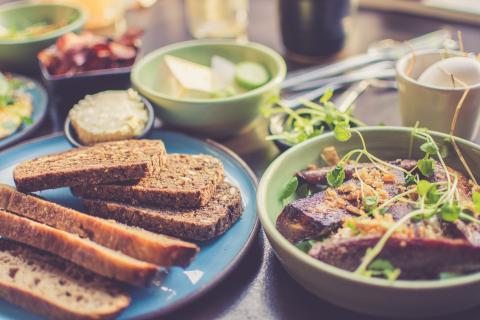10 Tips for Eating Better on a Budget
SHARE

Eating better on a budget is simpler, and more cost effective, than you might think. No longer do you have to sacrifice taste, flavor, and healthful foods when watching how much you spend. There are many tips and tricks that allow you to eat the foods you want, and need, without costing extra.
- Plan. The number one step to not spending extra is plan for what you want, and need, to buy . Create a shopping list every time you go to the grocery store and try to include food from each food group. Including all food groups provides your body with essential nutrients you need to stay healthy. Do not forget to bring the list to the grocery store and to stick to it!
- Check for deals. Look at the local newspaper, grocery store flyers, and deals online to ensure you are getting the best price. If you see a coupon for an item but do not typically buy it, this might seem like a deal at first, but in reality, you’re actually spending more money than you normally would. Only clip coupons for items you need.
- Learn to Unit Price. When shopping look for the unit price below each item. This tells you how much you are paying per pound or ounce. Use this to compare different brands and foods to save more on your grocery bill.
- Try canned or frozen. Frozen and canned fruits and vegetables can be much cheaper than fresh produce, and still contain a good amount of nutrients. Check to make sure the fruit is not stored in heavy syrup or does not have added sugar and choose canned vegetables that are lower in sodium. A healthy option is to always rinse your canned fruits or vegetables to eliminate the extra sodium or added sugar. Canned and frozen vegetables are great to add to soups, stews, casseroles, pasta, and rice dishes. Frozen and canned fruit are great in smoothies, yogurt, oatmeal, or pies.
- Buy in season. If fresh fruits and vegetables are available, they are less expensive when they are in season. You can even buy extra and freeze them to be used later in the year. To see how to freeze vegetables check out our guide here https://extension.unh.edu/resource/freezing-vegetables
- Buy in bulk. Most foods are always cheaper when they are in bulk. Though make sure you can eat, or store the food, before it spoils or else you might be spending more than you are saving. Less expensive bulk items are usually meat, frozen vegetables, potatoes, and onions. Freeze leftover meats to be used later, and store vegetables like potatoes and onions in a cool dry place.
- Limit pre-made meals. Convenience foods and pre-made meals are more expensive than if you make the meal yourself. They also are higher in sodium and tend to be less healthy than homemade meals. Limit purchasing these items and set some time each week to learn to make your own meal.
- Cook once, eat all week. When taking the time to cook a meal, cook double or triple the amount so you have leftovers during the week. You can reinvent those leftovers by adding new spices, ingredients or even cooking it a different way. If you made roasted chicken and potatoes you could turn that into a burrito, casserole, stir fry, chicken salad or soup just by adding a few different ingredients.
- Vary your protein choices. Although meat might be the typical protein choice it is usually more expensive. Save on money by switching to plant-based proteins such as beans and legumes. These include pinto, kidney, black and garbanzo beans as well as lentils. They make a great addition to pastas, soups, salads or are delicious on their own with some seasoning.
- Limit eating out. Eating at restaurants, even fast-food, can add up to more than you think. Limit restaurant, or away-from-home, meals to once to two times per week. This not only will cut down on costs but will also help you eat a little healthier.
Author(s)
Categories
